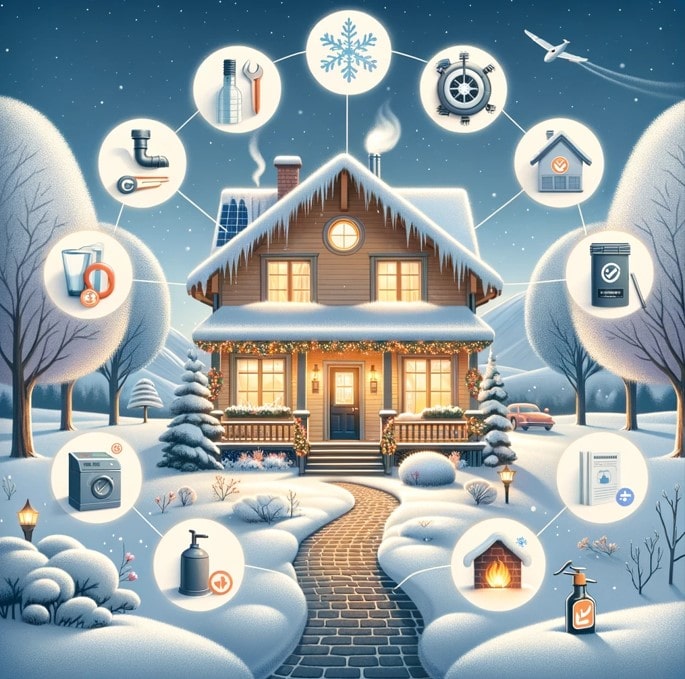With the arrival of freezing temperatures, winter maintenance for your home becomes a priority to ensure comfort and safety. Winter isn't just a time for celebration and comfort; it's also a time to ensure your home is well-prepared to withstand the harsh Quebec climate.
In this article, we reveal the crucial steps to ensure the safety, comfort, and energy efficiency of your home. From maintaining your heating system and thermal insulation to preparing your plumbing and protecting your garden, each tip is designed to guide you in optimally preserving your home during winter.
Prepare to face the cold with peace of mind thanks to these ten tips!
1. Heating System Maintenance
Before winter arrives, it's crucial to ensure your heating system is operating optimally. Here are some key maintenance points to remember:
- Professional Inspection: Have your heating system checked by a specialist. This ensures its proper functioning and prevents safety risks.
- Replacing Filters: Change your air filters regularly. Clean filters improve your heating efficiency and air quality.
- Duct Cleaning: Make sure the ducts are clean to maintain good air circulation and better system efficiency.
Proper maintenance will help you stay warm and safe all winter long and reduce your heating bills.
2. Improved Thermal Insulation
Proper insulation is essential to keeping your home comfortable and energy-efficient during the winter. Here's how to achieve it:
- Check Windows and Doors: Inspect the caulking around windows and doors. Replace seals if necessary to prevent cold drafts.
- Ventilation Grilles: Make sure the ventilation grilles are not blocked. Proper ventilation is crucial to prevent moisture problems and ensure healthy air quality.
- General Insulation: Consider checking the insulation of your walls, attic, and basement. Proper insulation helps retain heat and reduce heating costs.
By following these steps, you can improve your home's energy efficiency and create a more comfortable environment for the winter. This way, you'll reduce your electricity bill by avoiding heating the exterior of your home.
4. Plumbing Preparation
Winter can be unforgiving to your plumbing, especially if the pipes freeze. Here's how to protect them:
- Pipe Insulation: Wrap pipes exposed to the cold, especially in unheated spaces like the garage or basement, with special pipe insulation. This helps prevent freezing and possible bursts.
- Disconnecting Garden Hoses: Before temperatures drop, disconnect and drain outdoor garden hoses. Also, turn off the outdoor water supply valve to prevent any remaining water in the hoses from freezing and damaging the pipes.
These simple precautions can save you from costly repairs due to frozen pipes during the winter months.
5. Maintenance of Chimneys and Fireplaces
To safely enjoy the comforting warmth of your fireplace or fireplace during the winter, proper maintenance is essential. Here's what to do:
- Inspection and Chimney Sweeping: Have your chimney inspected and swept at least once a year by a professional. This ensures proper combustion and prevents the risk of fire. Sweeping removes buildup of soot and creosote, flammable substances that can cause chimney fires.
- Leak Testing: Make sure your chimney connection joints are airtight. Faulty joints can allow dangerous gases to escape into your home.
These steps are essential to ensure the safe and efficient operation of your fireplace or chimney, and to provide you with a reliable heat source during the cold months.
6. Preparation of the Ground and the Garden
The arrival of winter requires special attention to your garden and outdoor space to keep them healthy:
- Cleaning Garden Furniture: Before the cold weather sets in, carefully clean and store your garden furniture. This will extend its lifespan and protect it from the harsh winter weather.
- Last Lawn Mowing: Give your lawn a final mow before winter. This will help prevent the grass from becoming overgrown and likely harboring pests and diseases during the cold months.
- Winter Fertilizer Application: Use a winter-specific fertilizer to nourish your lawn and strengthen its roots, preparing it to better withstand the cold and bounce back in spring.
- Collection of Dead Leaves: Remove dead leaves and other debris from your lawn and flowerbeds. Leaves left on the ground can promote the growth of mold and fungal diseases.
These actions will help maintain the health of your garden and outdoor space, even during cold weather.
8. Snow Removal and De-Icing
Clearing snow and ice from driveways and entrances is a crucial part of winter preparation to ensure your safety. Here's how to do it effectively:
- Regular Snow Removal: Remove accumulated snow from your walkways, driveways, and steps regularly. Frequent snow removal prevents the formation of hard, dangerous layers of ice.
- Use of De-Icing Products: Apply appropriate de-icing products to areas where ice tends to form. Choose products that are safe for your plants and won't damage the concrete.
- Crossing Safety: Make sure the paths to and around your home are always clear and safe. This is especially important for emergency exits.
Keeping your driveways and entrances free of snow and ice helps prevent accidents and ensure easy and safe access to your home throughout the winter.
9. Indoor Temperature Monitoring
Effective indoor temperature management is essential for optimal comfort and energy savings during winter. Here's how to achieve it:
- Constant Temperature: Maintain a constant indoor temperature, even when you're not home. This helps avoid sudden changes in temperature that can overload your heating system and increase your energy bills.
- Using a Smart Thermostat: Consider installing a smart thermostat. These devices automatically regulate the temperature based on your habits and presence. They can be programmed or controlled remotely, giving you greater flexibility and control over your home's heating.
By monitoring and adjusting your indoor temperature, you create a more comfortable environment while optimizing the use of your heating system.
10. After Winter
Once winter is over, it's important to ensure your home hasn't suffered any weather-related damage. Here are the key steps for post-winter:
- Gutter Cleaning: Clean your gutters to remove debris that accumulates during the winter, such as dead leaves and branches. Clean gutters allow for better rainwater drainage and reduce the risk of water infiltration.
- Roof Inspection: Check your roof for damage caused by heavy snow or icicles, such as missing, cracked, or damaged shingles. A quick inspection can help you identify necessary repairs before they become more serious problems.
By performing these maintenance procedures after winter, you help extend the life of your roof and gutters, while preserving the structural integrity of your home.
Conclusion




